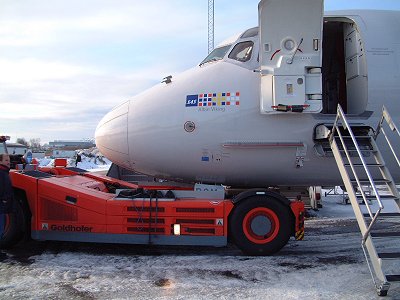5. PUSH BACK.
At ESGG the pushback clearance is coordinated via the ground personal. We do not need to call the tower and ask for push. The first person to contact is therefor our mechanic. This conversation is a mix of Swedish and English, normally referred to as "SASPIRANTO".
ICING CONDITIONS.Today only engine ice is present. This is a short description of the whole procedure to make a departure during icing conditions.ENGINE ICE. During ground operation (use OAT), takeoff and approach (use RAT), engine anti-ice shall be used whenever the temperature is +6°C or less and either the dewpoint is at or within 3° of ambient temperature or moist conditions are evident ( such as rain, sleet, snow, fog or water, ice on the taxiway or runway). Engine anti-ice shall also be turned on before entering clouds when RAT is between +6° and -10°. During ground operations at temperatures of +3° or below and simultaneous high moisture conditions (rain, sleet, snow or fog) the engine anti-ice system may not be capable of keeping the engines clear of ice during prolonged taxiing and/or long periods of idling. Periodic run-ups (70% N1 for a minimum of 15 seconds or alternately 60% for minimum of 40 seconds) shall be made in these conditions. Such run-ups need not normally be made more frequently than at 10 minutes intervals. All takeoffs during this condition or after de/anti-ice treatment shall be preceded by an engine run-up. AIRFOIL ICE. Before departure the aircraft shall be free of ice, snow and slush on the wings, tail surface and fuselage. Frost on the underside of the wing tank area is permitted provided the thickness does not exceed 3 mm. No performance corrections for this condition is required. If taking off in icing conditions, the airfoil anti-ice system shall be switched on before takeoff to permit airfoil anti-ice immediately after liftoff. The system is not active during ground operation.Airfoil icing conditions can exist when RAT is 6° or less and there is visible moisture in the air. Be alert for ice buildup on windshield wipers or edges of windshields. During flight in continuous icing conditions, operate the tail de-ice system approximately every 20 minutes and also about one minute before final flap setting. Anti-icing is a precautionary method by which clean or de-iced aircraft surfaces are protected against the formation of frost or ice, or accumulation of snow or slush, for limited period of time. De-icing. De-icing is a procedure by which frost, ice and snow is removed from the aircraft surfaces. Holdover time HOT. Holdover time is the estimated time the anti-icing fluid will prevent frost, ice and snow to form or accumulate on the protected (treated) areas of the aircraft. HOT starts at the beginning of the final anti-ice treatment. A HOT table is published, giving HOT as a function of applied fluid, temperature and weather. For each condition the table gives a range of HOT (eg 30-45 minutes) and it is the responsibility of the Commander to determine what HOT can be expected under prevailing conditions.
|
| Go back toFlying the MD80 | Move on toTaxi. |